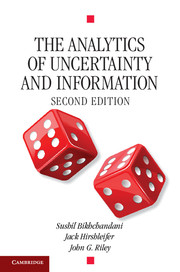Book contents
- Frontmatter
- Contents
- Acknowledgments
- In Memoriam
- Introduction
- Part I
- Part II
- 5 Information and Informational Decisions
- 6 Information and Markets
- 7 Strategic Uncertainty and Equilibrium Concepts
- 8 Informational Asymmetry and Contract Design
- 9 Competition and Hidden Knowledge
- 10 Market Institutions
- 11 Long-Run Relationships and the Credibility of Threats and Promises
- 12 Information Transmission, Acquisition, and Aggregation
- Index
- References
10 - Market Institutions
Published online by Cambridge University Press: 05 August 2013
- Frontmatter
- Contents
- Acknowledgments
- In Memoriam
- Introduction
- Part I
- Part II
- 5 Information and Informational Decisions
- 6 Information and Markets
- 7 Strategic Uncertainty and Equilibrium Concepts
- 8 Informational Asymmetry and Contract Design
- 9 Competition and Hidden Knowledge
- 10 Market Institutions
- 11 Long-Run Relationships and the Credibility of Threats and Promises
- 12 Information Transmission, Acquisition, and Aggregation
- Index
- References
Summary
Market institutions come into place to solve extant problems. For example, with the advent of large corporations and multi-location merchandising in the early nineteenth century, posted prices replaced bargaining as the preferred method of retail. More recently, prompted by advances in technology, which make it possible to serve geographically-dispersed bidders, auctions have increased in popularity. At the same time, in transactions involving real estate or cars, prices are determined through negotiations. In this chapter we explore some of the reasons underlying this variety of selling methods. In Sections 10.1 and 10.2 we assume that the seller has the ability to choose and commit to any selling method she likes. Under this assumption, the seller will find it optimal to either post a take-it-or-leave-it price or conduct an auction. When this assumption is relaxed (in Section 10.3), it leads to bargaining between the seller and the buyer.
Posted-Price Markets
A seller has one indivisible object to sell to a buyer. The seller's cost is normalized to zero. The buyer values the object at V ⩾ 0. The seller does not know V and believes that it is drawn from a probability distribution F(V) with positive density f(V). The seller has the power to decide how to sell the object and can choose any market institution that she likes. What should the seller do?
- Type
- Chapter
- Information
- The Analytics of Uncertainty and Information , pp. 367 - 421Publisher: Cambridge University PressPrint publication year: 2013

